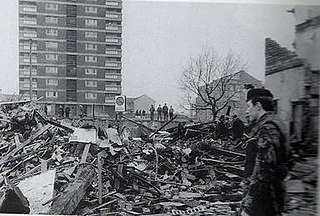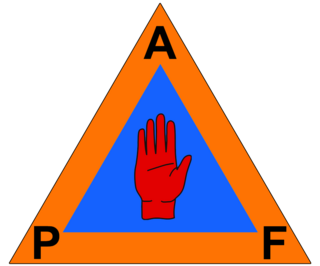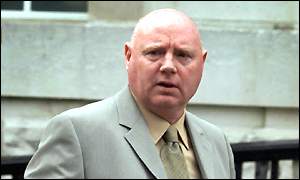
The Ulster Volunteer Force (UVF) is an Ulster loyalist paramilitary group based in Northern Ireland. Formed in 1965, it first emerged in 1966. Its first leader was Gusty Spence, a former British Army soldier from Northern Ireland. The group undertook an armed campaign of almost thirty years during The Troubles. It declared a ceasefire in 1994 and officially ended its campaign in 2007, although some of its members have continued to engage in violence and criminal activities. The group is a proscribed organisation and is on the terrorist organisation list of the United Kingdom.

William Moore, was a Northern Irish loyalist. He was a member of the Shankill Butchers, an Ulster Volunteer Force (UVF) gang. It was Moore who provided the black taxi and butcher knives which the gang used to carry out its killings. Following ringleader Lenny Murphy's arrest, Moore took over as the de facto leader of the gang and the killings continued.

The Irish People's Liberation Organisation was a small Irish socialist republican paramilitary organisation formed in 1986 by disaffected and expelled members of the Irish National Liberation Army (INLA), whose factions coalesced in the aftermath of the supergrass trials. It developed a reputation for intra-republican and sectarian violence as well as criminality, before being forcibly disbanded by the Provisional Irish Republican Army (IRA) in 1992.

On 4 December 1971, the Ulster Volunteer Force (UVF), an Ulster loyalist paramilitary group, detonated a bomb at McGurk's Bar in Belfast, Northern Ireland, frequented by Irish Catholics–nationalists. The explosion caused the building to collapse, killing fifteen Catholic civilians—including two children—and wounding seventeen more. It was the deadliest attack in Belfast during the Troubles.

The Loughinisland massacre took place on 18 June 1994 in the small village of Loughinisland, County Down, Northern Ireland. Members of the Ulster Volunteer Force (UVF), a loyalist paramilitary group, burst into a pub with assault rifles and fired on the customers, killing six civilians and wounding five. The pub was targeted because it was frequented mainly by Catholics, and was crowded with people watching the Republic of Ireland play against Italy in the 1994 FIFA World Cup. It is thus sometimes called the "World Cup massacre". The UVF claimed the attack was retaliation for the killing of three UVF members by the Irish National Liberation Army (INLA).

The Protestant Action Force (PAF) was a front group used by Ulster loyalist paramilitaries in Northern Ireland when claiming responsibility for a number of attacks during the Troubles. First used in 1974, attacks by individuals claiming to be members of the PAF killed at least 41 Catholic civilians. The PAF was most commonly used by members of the Ulster Volunteer Force (UVF). All of the attacks claimed by the PAF in Armagh and Tyrone counties from 1974 to 1976 have been linked to the Glenanne gang, which was a group consisting of members of the UVF Mid-Ulster Brigade along with rogue Ulster Defence Regiment (UDR) soldiers and Royal Ulster Constabulary (RUC) police officers. A six-year period of no attacks claimed by the PAF ended in 1982; during the 1980's, the PAF claimed 15 attacks in the Belfast area and two in County Armagh. UDR soldiers were convicted of two attacks in Armagh. The PAF claimed its last attacks in the early 1990's, all of which were in north Armagh and were alleged to involve members of the security forces.
The Reavey and O'Dowd killings were two co-ordinated gun attacks on 4 January 1976 in County Armagh, Northern Ireland. Six Catholic civilians died after members of the Ulster Volunteer Force (UVF), an Ulster loyalist paramilitary group, broke into their homes and shot them. Three members of the Reavey family were shot at their home in Whitecross and four members of the O'Dowd family were shot at their home in Ballydougan. Two of the Reaveys and three of the O'Dowds were killed outright, with the third Reavey victim dying of brain hemorrhage almost a month later.

William "Billy" Stobie was an Ulster Defence Association (UDA) quartermaster and RUC Special Branch informer who was involved in the shootings of student Adam Lambert in 1987 and solicitor Pat Finucane in 1989.
Colin Duffy is an Irish republican, described by the BBC as the most recognisable name and face among dissident republicans in Northern Ireland. He was cleared of murder charges in three court cases involving police and army killings.
This is a timeline of actions by the Ulster Volunteer Force (UVF), an Ulster loyalist paramilitary group since 1966. It includes actions carried out by the Red Hand Commando (RHC), a group integrated into the UVF shortly after their formation in 1972. It also includes attacks claimed by the Protestant Action Force (PAF), a covername used by the UVF. Most of these actions took place during the conflict known as "the Troubles" in Northern Ireland.

The Tandragee killings took place in the early hours of Saturday 19 February 2000 on an isolated country road outside Tandragee, County Armagh, Northern Ireland. Two young Protestant men, Andrew Robb and David McIlwaine, were beaten and repeatedly stabbed to death in what was part of a Loyalist feud between the Ulster Volunteer Force (UVF) and their rivals, the breakaway Loyalist Volunteer Force (LVF). The men were not members of any loyalist paramilitary organisation. It later emerged in court hearings that Robb had made disparaging remarks about the killing of UVF Mid-Ulster Brigade leader Richard Jameson by an LVF gunman the previous month. This had angered the killers, themselves members of the Mid-Ulster UVF, and in retaliation they had lured the two men to the remote lane on the outskirts of town, where they killed and mutilated them.
The 1991 Cappagh killings was a gun attack by the loyalist Ulster Volunteer Force (UVF) on 3 March 1991 in the village of Cappagh, County Tyrone, Northern Ireland. A unit of the UVF's Mid-Ulster Brigade drove to the staunchly republican village and shot dead three Provisional IRA members and a Catholic civilian at Boyle's Bar.

William Wesley Somerville was an Ulster loyalist militant, who held the rank of lieutenant in the Ulster Volunteer Force's (UVF) Mid-Ulster Brigade during the period of conflict known as "the Troubles". With claims that his brother and Wesley were a part of the UDR Ulster Defence Regiment which was later found to be false. Somerville was part of the UVF unit that ambushed the Irish cabaret band The Miami Showband at Buskhill, County Down, which resulted in the deaths of three of the bandmembers. Somerville killed himself, along with Harris Boyle, when the bomb they had loaded onto the band's minibus exploded prematurely. His brother, John James Somerville, was one of the three convicted murderers of bandmembers Brian McCoy, Fran O'Toole and Tony Geraghty.

The Shore Road is a major arterial route and area of housing and commerce that runs through north Belfast and Newtownabbey in Northern Ireland. It forms part of the A2 road, a traffic route which links Belfast to the County Antrim coast.
Albert Wallace "Ginger" Baker is an Ulster loyalist who was convicted of four murders carried out by the Ulster Defence Association (UDA), of which he was a leading member. He turned himself in to the police in 1973 after throwing a hand grenade into a bus transporting Catholic workmen in East Belfast, Northern Ireland, which killed one man. He admitted to this killing and those of three other Catholics the previous year, as well as 11 armed robberies. He was sentenced to 25 years imprisonment for the four murders.

On 5 February 1992, there was a mass shooting at the Sean Graham bookmaker's shop on the Lower Ormeau Road in Belfast, Northern Ireland. Members of the Ulster Defence Association (UDA), a loyalist paramilitary group, opened fire on the customers with an assault rifle and handgun, killing five civilians and wounding nine. The shop was in a Catholic and Irish nationalist area, and all of the victims were local Catholics. The UDA claimed responsibility using the cover name "Ulster Freedom Fighters", saying the shooting was retaliation for the Teebane bombing, which had been carried out by the Provisional IRA less than three weeks before. A later investigation by the Police Ombudsman found that the Royal Ulster Constabulary (RUC) had engaged in "collusive behaviour" with UDA informers involved in the attack.
John "Bunter" Graham is a long-standing prominent Ulster loyalist figure. Born in the Lower Shankill, Graham rose quickly through the ranks of the Ulster Volunteer Force (UVF), joining other UVF leaders at a rally at Stormont in 1974 to celebrate the collapse of power sharing.
Harry Stockman, also known as "Harmless" is a Northern Irish loyalist and a senior member of the Ulster Volunteer Force (UVF) paramilitary organisation. He serves as the commander of the UVF 1st Battalion Shankill Road and is allegedly the second-in-command on the UVF Brigade Staff. His uncle was Robert "Basher" Bates, a member of the notorious Shankill Butchers gang.
Raymond Irvine McCord is a victims rights campaigner from Northern Ireland. McCord became involved in the issue of victims rights after his son, Raymond McCord Jr., was killed by the loyalist paramilitary group the Ulster Volunteer Force (UVF) in 1997. He is an outspoken critic of the UVF.
Gary Haggarty is a former leader of an Ulster Volunteer Force unit in the Mount Vernon area of north Belfast and police "supergrass". In January 2018 he was sentenced to more than six years in jail after admitting to over 200 offences, including committing five murders.












